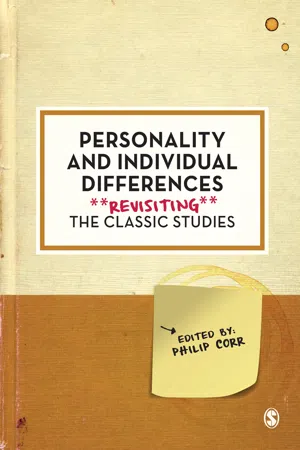
Personality and Individual Differences
Revisiting the Classic Studies
Philip Corr
- 296 pagine
- English
- ePUB (disponibile sull'app)
- Disponibile su iOS e Android
Personality and Individual Differences
Revisiting the Classic Studies
Philip Corr
Informazioni sul libro
Revisiting the Classic Studies is a series of texts that introduces readers to the studies in psychology that changed the way we think about core topics in the discipline today. It provokes students to ask more interesting and challenging questions about the field by encouraging a deeper level of engagement, both with the details of the studies themselves and with the nature of their contribution.
Edited by leading scholars in their field and written by researchers at the cutting edge of these developments, the chapters in each text provide details of the original works and their theoretical and empirical impact, and then discuss the ways in which thinking and research has advanced in the years since the studies were conducted.
Personality and Individual Differences: Revisiting the Classic Studies traces 14 ground-breaking studies by researchers such as Hans Eysenck, Raymond Cattell, Ernest Tupes and Raymond Christal to re-examine and reflect on their findings and engage in a lively discussion of the subsequent work that they have inspired.
Domande frequenti
Informazioni
1 Assessing and Enumerating Personality Dimensions Revisiting Webb (1915)
Background to the study
We therefore venture to suggest (tentatively and with much desire for further evidence) that the nature of the second factor [after general intelligence], whose generality would appear to extend so widely in character, is in some close relation to ‘persistence of motives.’ This conception may be understood to mean consistency of action resulting from deliberate volition, or will. (For convenience, we shall in future represent the general factor by the symbol ‘w’.) (p. 60)
Detailed description of the study
Style
A few of these unwarranted generalisations [concerning human psychological variation, by past writers] which have been put forward are passion, will, pleasures and pains and their corresponding interests; strength and weakness of activity; speed of activity; vitality (sanguine, choleric, etc.); primary and secondary functions; spontaneity; easy and difficult reactibility … But all that these writers have really done is to observe a person’s actions to have certain characteristics under certain particular conditions. They have never produced, nor even tried to produce, any evidence of the same person exhibiting the same characteristics generally, that is to say, under varied conditions.
Design
Indice dei contenuti
- Cover
- Half Title
- Publisher Note
- Title Page
- Copyright Page
- Contents
- About the Editor
- About the Contributors
- Introduction Revisiting Classic Studies in Personality and Individual Differences
- 1 Assessing and Enumerating Personality Dimensions Revisiting Webb (1915)
- 2 Classification of Trait-Names Revisiting Allport and Odbert (1936)
- 3 Factor Analysis of Trait-Names Revisiting Cattell (1943)
- 4 The Dimensional Model of Personality and Psychopathology Revisiting Eysenck (1944)
- 5 Five Strong and Recurrent Personality Factors Revisiting Tupes and Christal (1961)
- 6 The Challenge to Trait Theory Revisiting Mischel (1968)
- 7 Sensitivity to Punishment and Reward Revisiting Gray (1970)
- 8 Effects of Rewards on Self-Determination and Intrinsic Motivation Revisiting Deci (1971)
- 9 Genetic Influences on Behaviour Revisiting Bouchard et al. (1990)
- 10 The Evolution of Personality Revisiting Buss (1991)
- 11 Personality, Health and Death Revisiting Friedman et al. (1993)
- 12 Realistic Ratings of Personality Revisiting Funder (1995)
- 13 Personality Traits as State Density Distributions Revisiting Fleeson (2001)
- 14 The Dark Side of Personality Revisiting Paulhus and Williams (2002)
- Author Index
- Subject Index